D-Link MU-MIMO WiFi Nano USB Adapter DWA-181 User Guide
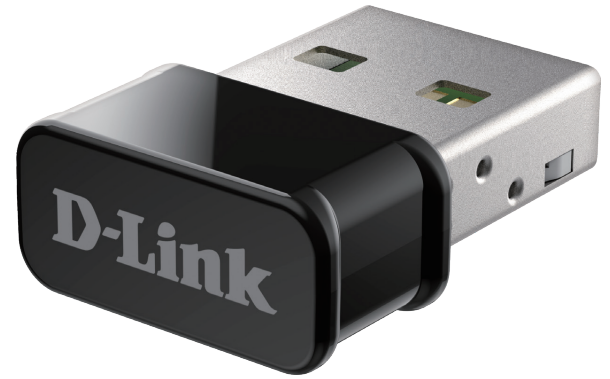
Content
Introduction
The D-Link AC1300 MU-MIMO Wi-Fi Nano USB Adapter DWA-181 delivers powerful wireless AC technology to your desktop or notebook computer. Simply plug the adapter into an available USB port and connect to a wireless network to access a secure, high-speed internet connection – 2.4 GHz (400Mbps) or 5 GHz (up to 867Mbps). And with integrated Dual Band technology, you’ll have reduced Wi-Fi interference to maximize throughput for faster streaming, gaming, and Skype calls. The adapter is priced at approximately $21.28.
Interference-Free Bandwidth
The AC1300 MU-MIMO Wi-Fi Nano USB Adapter (DWA-181) delivers Dual Band technology to your home network for intelligent, versatile, interference-free bandwidth. Check your email and surf the Internet on the 2.4 GHz band; or game, make Skype calls and stream HD movies to multiple devices using the cleaner, interference-free 5 GHz band. Whatever you like to do online, Dual Band has you covered.
Compatible With All Your Wireless Products
While the AC1300 MU-MIMO Wi-Fi Nano USB Adapter delivers cutting-edge 802.11ac speed to your home network, it’s also backward compatible with all of your current wireless products – no updates or adapters necessary.
What is wireless AC?
802.11ac is a new networking standard that produces high-throughput wireless speed on the 5 GHz band.
What does this mean for your home network?
Flawless HD video streaming, faster gaming, and lag-free Skype and Facetime calls, all with less Wi-Fi interference for smooth, lightning-fast performance. And while your home gains all the cutting-edge benefi ts of 11ac, D-Link’s AC1300 MU-MIMO Wi-Fi Nano USB Adapter is also compatible with all of your current Wireless N products. “Maximum wireless signal rate derived from IEEE 802.11ac specification and IEEE Standard 802.11n specification. D-Link makes no warranties as to forward compatibility with future standards or compatibility with 802.11ac devices from other manufacturers. Actual data throughput will vary.
Network conditions and environmental factors, including volume of network traffic, building materials and construction, and network overhead, lower actual data throughput rate. Environmental factors may adversely affect wireless signal range. Up to 867Mbps wireless speeds achieved when connecting to other 802.11ac devices.
Data throughput may also be limited by the product’s interface, less than 480 Mbps for a USB 2.0 interface. The inclusion of a specific product or manufacturer does not imply its endorsement of D-Link or the D-Link product. Computer must adhere to Microsoft’s recommended System Requirements.”
Features
- IEEE 802.11ac, 802.11n, 802.11g, 802.11b, and 802.11a compliant
- Dual band N technology for use in 2.4 GHz or 5 GHz networks
- Wireless AC wave 2 technology for superior wireless performance
- Access secure networks using WPA™ or WPA2™
- Small USB design
Hardware Overview
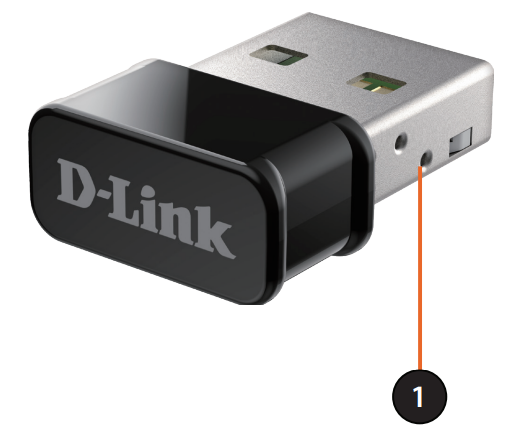
- USB Connector: Used to connect the DWA-181 to your computer.
Technical Specifications
- Standards
- IEEE 802.11ac
- IEEE 802.11n
- IEEE 802.11g
- IEEE 802.11b
- IEEE 802.11a
- Bus Type
- USB 2.0
- Security
- Wi-Fi Protected Access (WPA™ & WPA2™)
- Power Consumption
- Min: 167 mA
- Max: 338 mA
- Operating Voltage
- 5.0 VDC +/- 10%
- Operating Temperature
- 0 °C to 40 °C (32 °F to 104 °F )
- Storage Temperature
- -20 °C to 75 °C (-4 °F to 167 °F )
- Operating Humidity
- 10% to 90% maximum (non-condensing)
- Storage Humidity
- 5% to 95% maximum (non-condensing)
- Dimensions
- 20.2 x 14.9 x 7.1 mm (0.80 x 0.59 x 0.28 in)
- Weight
- 2.21g
- Certifications
- CE
- FCC
- IC
Description
The D-Link DWA-181 is engineered to provide a seamless WiFi experience. Its MU-MIMO technology ensures that multiple devices can connect to the network without competing for bandwidth, making it perfect for streaming, gaming, and other high-bandwidth activities. The adapter is also backward compatible with older WiFi standards, ensuring it works with a wide range of routers and access points.
The nano design makes it easy to plug in and forget, as it does not take up much space and does not obstruct other USB ports. This makes it an excellent choice for laptops, especially those with limited USB ports.
Installation
This section will walk you through the installation process. If you have a built-in wireless adapter, please disable it in the device manager before installing your D-Link adapter. Also, if you have previously installed another wireless adapter, please make sure any software is uninstalled.
Getting Started
Before installing your new D-Link wireless adapter, please verify the following:
- Remove any previous installations of wireless adapters
- Disable any built-in wireless adapters
- Verify the settings such as the SSID and security settings of the network(s) you want to connect to
Remove Existing Installations
If you’ve installed a different manufacture’s adapter or a different model D-Link adapter, make sure the software is uninstalled before installing the new software. Some utilities may cause a conflict with the new software. If you plan to use multiple adapters at different times, make sure the utilities are not set to load when your computer boots up.
To remove any old software:
- Windows 10 users: Click Start > All apps > Windows System > Control Panel > Programs > Uninstall a Program
- Windows 7/8 users: Click Start > Control Panel > Uninstall Programs
Disable Other Wireless Adapters
Most newer laptops may include a built-in wireless adapter. To prevent any conflicts with the D-Link wireless adapter, it is recommended to disable the wireless adapter (as well as any unused Ethernet adapters).
From the desktop, right-click on the My Computer icon and select Properties.
Click the Hardware tab and then click Device Manager. Scroll down the list and click the + sign to the left of Network Adapters.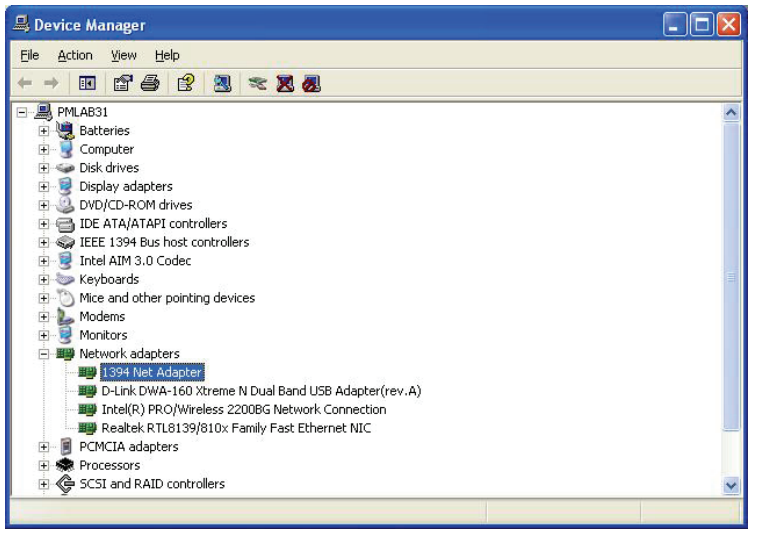
Right-click the adapter you would like to disable and select Disable.
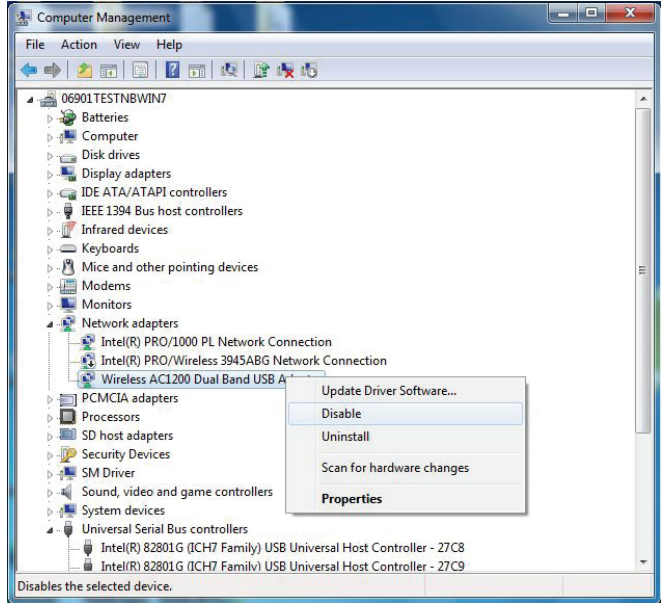
Click Yes to disable the adapter.

When the adapter is disabled, a down arrow or a grayed icon will be displayed.
Disabling the adapter will not remove the drivers. If you would like to use the adapter, simply right-click it and select Enable.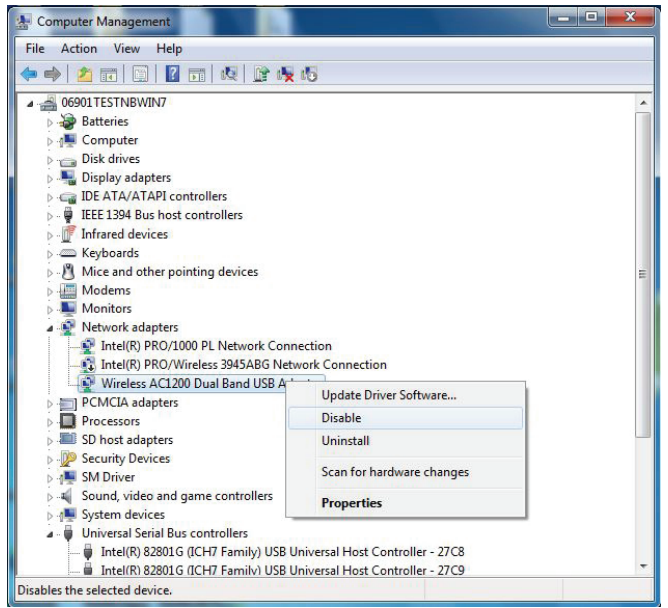
Wireless Installation Considerations
The D-Link wireless adapter lets you access your network using a wireless connection from virtually anywhere within the operating range of your wireless network. Keep in mind, however, that the number, thickness and location of walls, ceilings, or other objects that the wireless signals must pass through, may limit the range. Typical ranges vary depending on the types of materials and background RF (radio frequency) noise in your home or business. The key to maximizing wireless range is to follow these basic guidelines:
- Keep the number of walls and ceilings between the D-Link adapter and other network devices to a minimum - each wall or ceiling can reduce your adapter’s range from 3-90 feet (1-30 meters.) Position your devices so that the number of walls or ceilings is minimized.
- Be aware of the direct line between network devices. A wall that is 1.5 feet thick (.5 meters), at a 45-degree angle appears to be almost 3 feet (1 meter) thick. At a 2-degree angle it looks over 42 feet (14 meters) thick! Position devices so that the signal will travel straight through a wall or ceiling (instead of at an angle) for better reception.
- Building materials make a difference. A solid metal door or aluminum studs may have a negative effect on range. Try to position access points, wireless routers, and computers so that the signal passes through drywall or open doorways. Materials and objects such as glass, steel, metal, walls with insulation, water (fish tanks), mirrors, file cabinets, brick, and concrete will degrade your wireless signal.
- Keep your product away (at least 3-6 feet or 1-2 meters) from electrical devices or appliances that generate RF noise.
- If you are using 2.4 GHz cordless phones or X-10 (wireless products such as ceiling fans, lights, and home security systems), your wireless connection may degrade dramatically or drop completely. Make sure your 2.4 GHz phone base is as far away from your wireless devices as possible. The base transmits a signal even if the phone in not in use.
Adapter Installation
Warning: Do NOT install the DWA-181 adapter into your computer before installing the driver software from the D-Link CD.
Turn on the computer and Insert the D-Link DWA-181 Driver CD in the CD-ROM drive. If the CD Autorun function does not automatically start on your computer, go to Start > Run. In the run box type “D:\autorun.exe” (where D: represents the drive letter of your CD-ROM drive).
When the autorun screen appears, click Install.
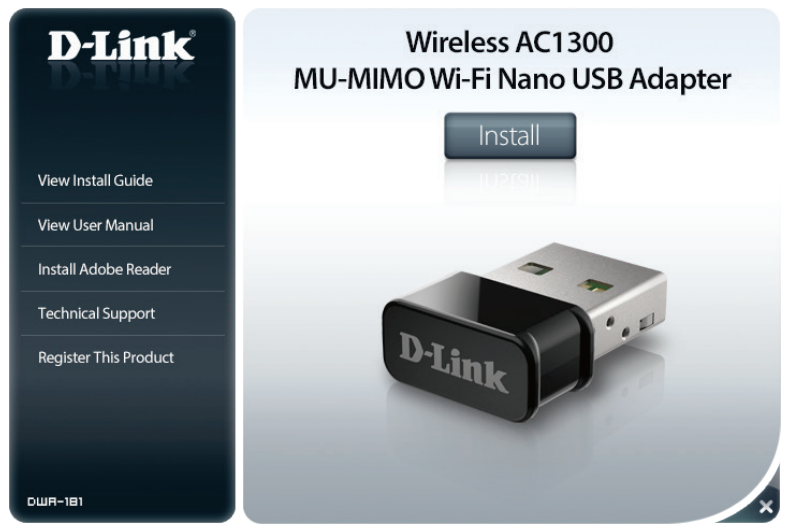
The welcome window will appear. Click Next to continue.
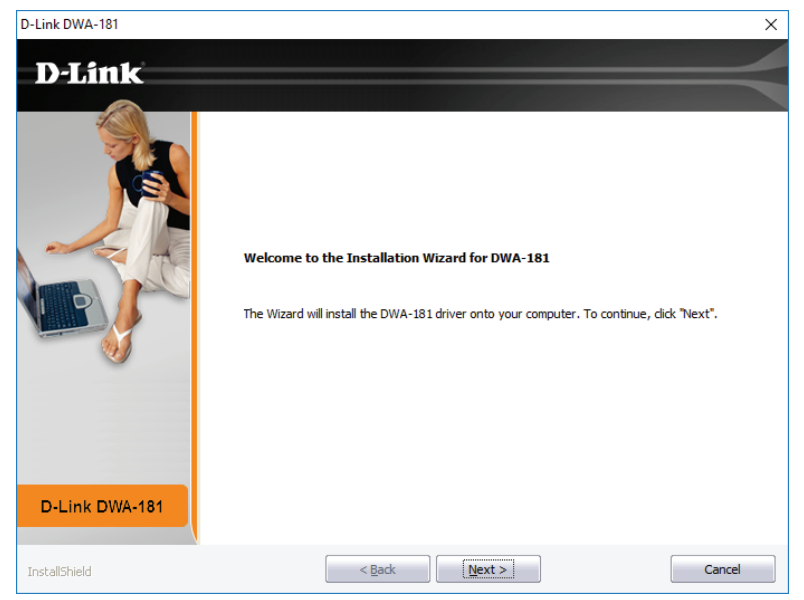
Insert the adapter into an available USB port on your computer. Click Install to continue.
If the Found New Hardware Wizard pops up, click Cancel in that new window.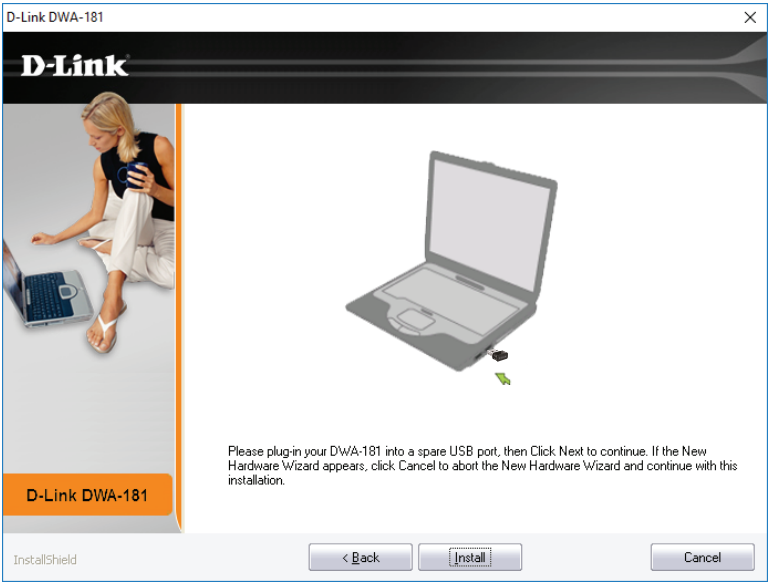
Setup Guide
To set up the D-Link DWA-181, follow these steps:
- Insert the adapter into an available USB port on your device.
- Install the drivers from the included CD or download them from the D-Link website.
- Launch the installation wizard and follow the prompts to complete the installation.
- Once installed, connect to your WiFi network by selecting it from the list of available networks and entering your network password.
Connect to a Wireless Network
Windows 10
To connect to a wireless network using Windows 10, you will need to know the wireless network name (SSID) and Wi-Fi password (security key) of the device you are connecting to.
To join an existing network, locate the wireless network icon in the taskbar, next to the time display and click on it.
Clicking on this icon will display a list of wireless networks which are within range of your computer. Select the desired network by clicking on its SSID.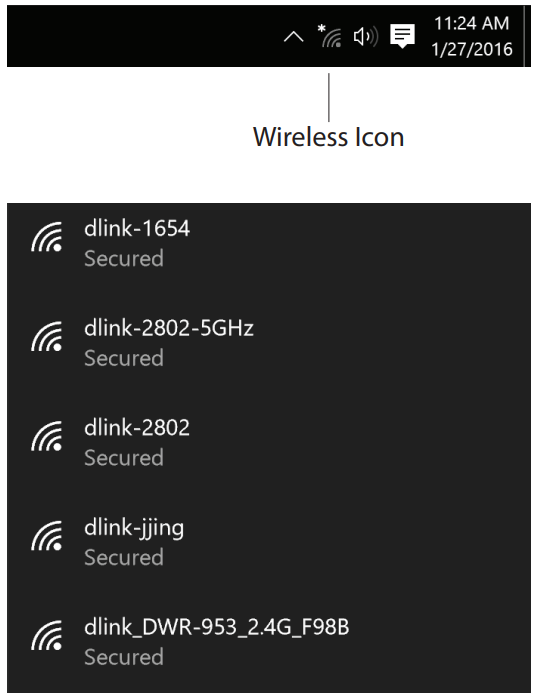
- To connect to the network, click Connect.
To automatically connect when your device is in range, click the Connect Automatically check box. Your computer will now automatically connect to this wireless network whenever it is detected. You will then be prompted to enter the Wi-Fi password (network security key) for the wireless network. Enter the password into the box and click Next to connect to the network.
It may take 20-30 seconds to connect to the wireless network. If the connection fails, please verify that the security settings are correct. The key or passphrase must be exactly the same as the one on the wireless router.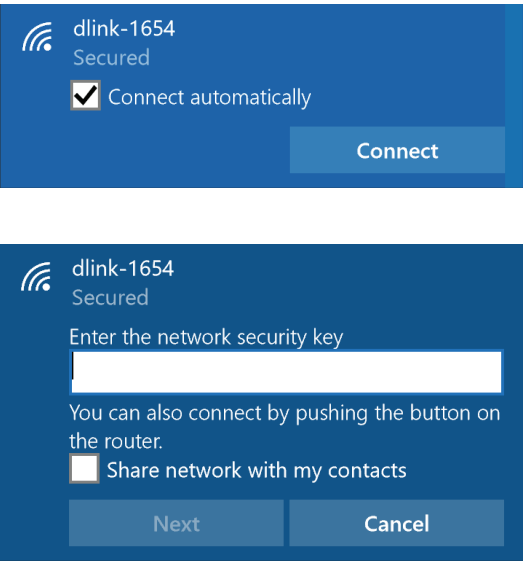
Windows 8.1/ Windows 8
- Click on the wireless computer icon in your system tray (lower-right corner next to the time).
- A list of available wireless networks will appear.
- Click the wireless network (SSID) you want to connect to and then click Connect.
If the network is secure/encrypted, enter the Wi-Fi password (security key) and click Next.

- Click either to enable or disable file sharing.
You will now be connected to your wireless network.
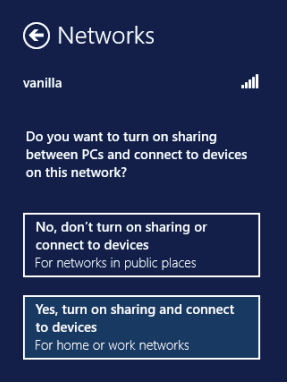
If you get a good signal but cannot access the Internet, confirm the encryption by reviewing the profile or check the TCP/IP settings for your wireless adapter. Refer to the Networking Basics section in this manual for more information.
Windows 7
- If you receive the Wireless Networks Detected bubble, click on the center of the bubble to access the utility.
or - Left-click the wireless icon in your system tray (lower-right corner next to the time).
- The utility will display any available wireless networks in your area. Click on a network (displayed using the SSID) and click the Connect button.
If you get a good signal but cannot access the Internet, check your TCP/IP settings for your wireless adapter.
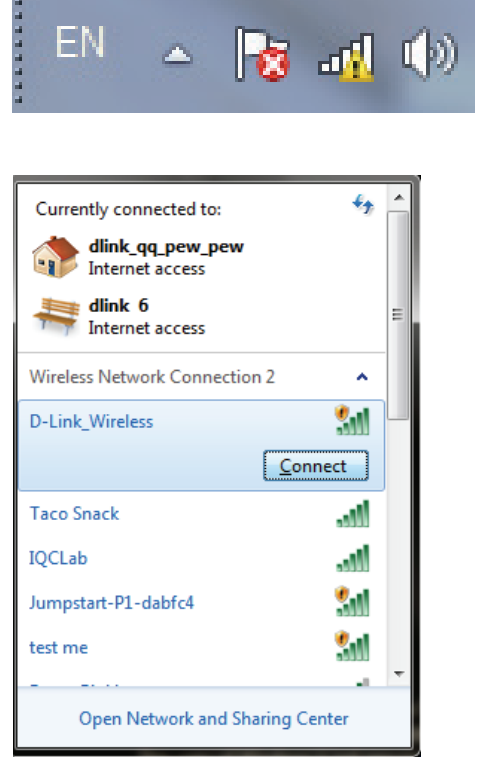
Wireless Security
This section will show you the different levels of security you can use to protect your data from intruders. The DWA-181 offers the following types of security:
- WPA/WPA2-Personal
- WPA/WPA2-Enterprise
What is WPA?
WPA, or Wi-Fi Protected Access, is a Wi-Fi standard that was designed to improve the security features of WEP (Wired Equivalent Privacy). The 2 major improvements over WEP:
- Improved data encryption through the Temporal Key Integrity Protocol (TKIP). TKIP scrambles the keys using a hashing algorithm and, by adding an integrity-checking feature, ensures that the keys haven’t been tampered with. WPA2™ is based on 802.11i and uses Advanced Encryption Standard instead of TKIP.
- User authentication, which is generally missing in WEP, through the extensible authentication protocol (EAP). WEP regulates access to a wireless network based on a computer’s hardware-specific MAC address, which is relatively simple to be sniffed out and stolen. EAP is built on a more secure public-key encryption system to ensure that only authorized network users can access the network.
WPA/WPA2-Personal uses a passphrase or key to authenticate your wireless connection. The key is an alpha-numeric password between 8 and 63 characters long. The password can include symbols (!?*&_) and spaces. This key must be the exact same key entered on your wireless router or access point.
WPA/WPA2-Enterprise incorporates user authentication through the Extensible Authentication Protocol (EAP). EAP is built on a more secure public key encryption system to ensure that only authorized network users can access the network.
Troubleshooting
This chapter provides solutions to problems that can occur during the installation and operation of the DWA-181. Read the following descriptions if you are having problems. The examples below are illustrated in Windows® 7. If you have a different operating system, the process on your computer will be similar.
- How do I know if my adapter is installed properly?
Go to Start > Computer (right-click) > Properties.
This will bring up the System settings under the Windows Control Panel.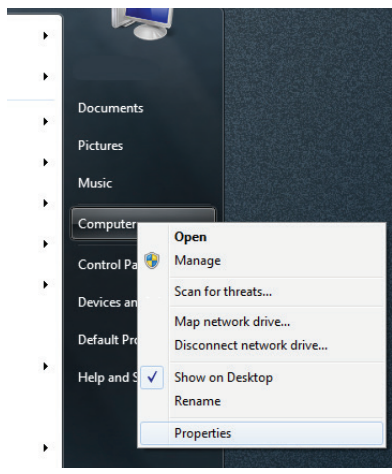
Click Device Manager.
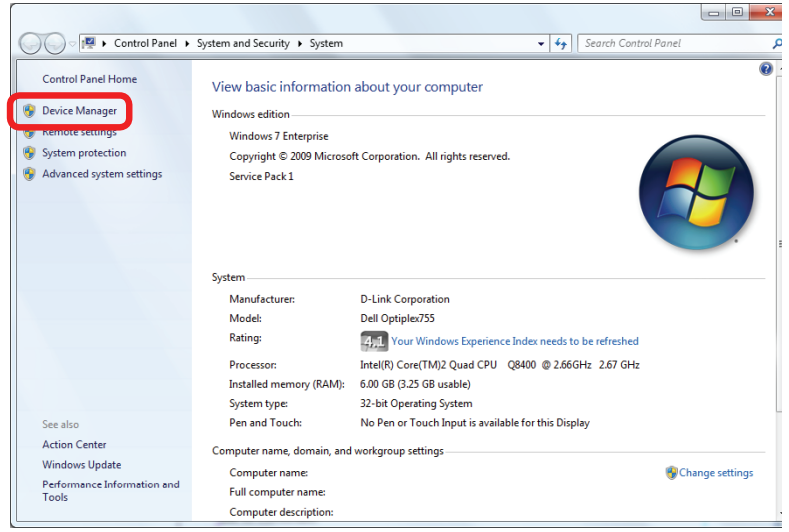
Click the + sign next to Network Adapters.
Right-click on D-Link DWA-181 USB Adapter.
Select Properties to check that the drivers are installed properly.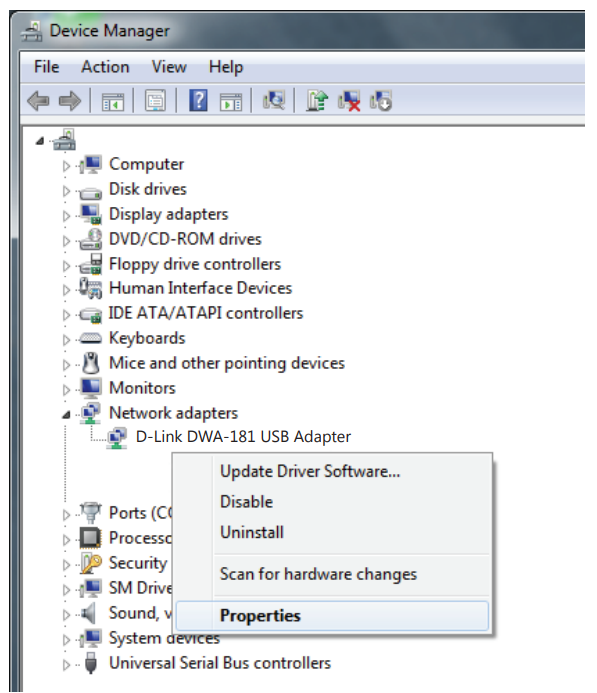
Look under Device Status to check that the device is working properly. Click OK to continue.
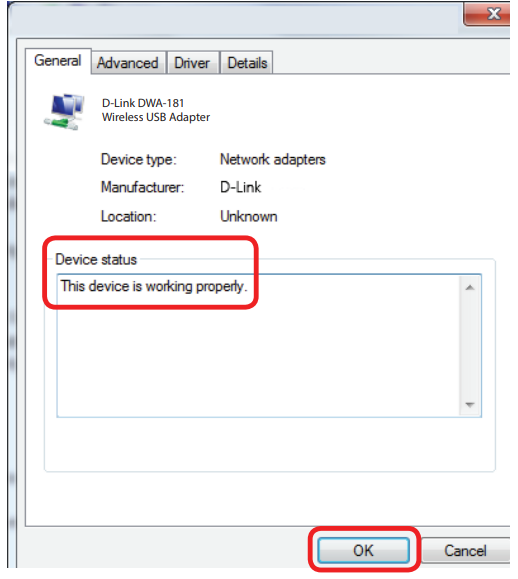
- The computer does not recognize the DWA-181 AC1300 MU-MIMO Wi-Fi Nano USB Adapter.
- Make sure that the DWA-181 AC1300 MU-MIMO Wi-Fi Nano USB Adapter is properly seated in the computer’s USB port.
- If Windows does not detect the hardware upon insertion of the adapter, make sure to completely remove drivers that were previously loaded.
- The computer with the DWA-181 installed is unable to connect to the wireless network and/or the Internet.
- Check that the LED indicators for the broadband modem are indicating normal activity. If not, there may be a problem with the broadband connection.
- Check that the LED indicators on the wireless router are functioning properly. If not, check that the AC power and Ethernet cables are firmly connected.
- Check that the IP address, subnet mask, gateway, and DNS settings are correctly entered for the network
- Check that the Network Connection for the wireless client is configured properly. Select AP (Infrastructure) when connecting to an access point. Double-click on the WLAN icon in the taskbar > click on Configuration to change the settings for the wireless adapter.
- If Security is enabled, make sure that the correct encryption keys are entered on both the DWA-181 and the access point. Double-click on the WLAN icon in the taskbar > click Encryption. Check to see that the key selected is set to the same key as other devices on the network.
Wireless Basics
D-Link wireless products are based on industry standards to provide easy-to-use and compatible high-speed wireless connectivity within your home, business or public access wireless networks. Strictly adhering to the IEEE standard, the D-Link wireless family of products will allow you to securely access the data you want, when and where you want it. You will be able to enjoy the freedom that wireless networking delivers.
A wireless local area network (WLAN) is a cellular computer network that transmits and receives data with radio signals instead of wires. Wireless LANs are used increasingly in both home and office environments, and public areas such as airports, coffee shops and universities. Innovative ways to utilize WLAN technology are helping people to work and communicate more efficiently. Increased mobility and the absence of cabling and other fixed infrastructure have proven to be beneficial for many users.
Wireless users can use the same applications they use on a wired network. Wireless adapter cards used on laptop and desktop systems support the same protocols as Ethernet adapter cards. Under many circumstances, it may be desirable for mobile network devices to link to a conventional Ethernet LAN in order to use servers, printers or an Internet connection supplied through the wired LAN. A wireless router is a device used to provide this link.
What is Wireless?
Wireless or Wi-Fi technology is another way of connecting your computer to the network without using wires. Wi-Fi uses radio frequency to connect wirelessly, so you have the freedom to connect computers anywhere in your home or office network.
Why D-Link Wireless?
D-Link is the worldwide leader and award winning designer, developer, and manufacturer of networking products. D-Link delivers the performance you need at a price you can afford. D-Link has all the products you need to build your network.
How does wireless work?
Wireless works similar to how cordless phone work, through radio signals to transmit data from one point A to point B. But wireless technology has restrictions as to how you can access the network. You must be within the wireless network range area to be able to connect your computer. There are two different types of wireless networks Wireless Local Area Network (WLAN), and Wireless Personal Area Network (WPAN).
Wireless Local Area Network (WLAN)
In a wireless local area network, a device called an Access Point (AP) connects computers to the network. The access point has a small antenna attached to it, which allows it to transmit data back and forth over radio signals. With an indoor access point as seen in the picture, the signal can travel up to 300 feet. With an outdoor access point the signal can reach out up to 30 miles to serve places like manufacturing plants, industrial locations, college and high school campuses, airports, golf courses, and many other outdoor venues.
Wireless Personal Area Network (WPAN)
Bluetooth is the industry standard wireless technology used for WPAN. Bluetooth devices in WPAN operate in a range up to 30 feet away.
Compared to WLAN, the speed and wireless operation range are both less than WLAN, but in return it doesn’t use nearly as much power which makes it ideal for personal devices, such as mobile phones, PDAs, headphones, laptops, speakers, and other devices that operate on batteries.
Who uses wireless?
- Wireless technology as become so popular in recent years that almost everyone is using it, whether it’s for home, office, business, D- Link has a wireless solution for it.
Home
- Gives everyone at home broadband access
- Surf the web, check email, instant message, and etc.
- Gets rid of the cables around the house
- Simple and easy to use
Small Office and Home Office
- Stay on top of everything at home as you would at office
- Remotely access your office network from home
- Share Internet connection and printer with multiple computers
- No need to dedicate office space
Where is wireless used?
Wireless technology is expanding everywhere not just at home or office. People like the freedom of mobility and it’s becoming so popular that more and more public facilities now provide wireless access to attract people. The wireless connection in public places is usually called “hotspots”.
Using a D-Link USB adapter with your laptop, you can access the hotspot to connect to Internet from remote locations like: airports, hotels, coffee shops, libraries, restaurants, and convention centers.
Wireless network is easy to setup, but if you’re installing it for the first time it could be quite a task not knowing where to start. That’s why we’ve put together a few setup steps and tips to help you through the process of setting up a wireless network.
Tips: Here are a few things to keep in mind, when you install a wireless network.
Centralize your router or access point
Make sure you place the router/access point in a centralized location within your network for the best performance. Try to place the router/access point as high as possible in the room, so the signal gets dispersed throughout your home. If you have a twostory home, you may need a repeater to boost the signal to extend the range.
Eliminate Interference
Place home appliances such as cordless telephones, Nanowaves, and televisions as far away as possible from the router/access point. This would significantly reduce any interference that the appliances might cause since they operate on same frequency.
Security
Don’t let your next-door neighbors or intruders connect to your wireless network. Secure your wireless network by turning on the WPA or WEP security feature on the router. Refer to product manual for detail information on how to set it up.
USB Adapter DWA-181 Wireless Modes
There are basically two modes of networking:
- Infrastructure – All wireless clients will connect to an access point or wireless router.
- Ad hoc – Directly connecting to another computer, for peer-to-peer communication, using wireless network adapters on each computer.
An Infrastructure network contains an access point or wireless router. All the wireless devices, or clients, will connect to the wireless router or access point.
An ad hoc network contains only clients, such as laptops with wireless USB adapters. All the adapters must be in ad hoc mode to communicate.
Networking Basics
Check your IP address
After you install your new D-Link wireless adapter and have established a wireless connection, by default, the TCP/IP settings should be set to obtain an IP address from a DHCP server (i.e. router) automatically. To verify your IP address, please follow the steps below.
- Click Start > All Programs > Accessories > Command Prompt. You may need administrative access to run this application.
- For all additional prompt windows inquiring of running the command prompt application, select Yes, OK, or Continue.
- At the prompt, type ipconfig and press Enter.
This will display the IP address, subnet mask, and default gateway of your adapter.
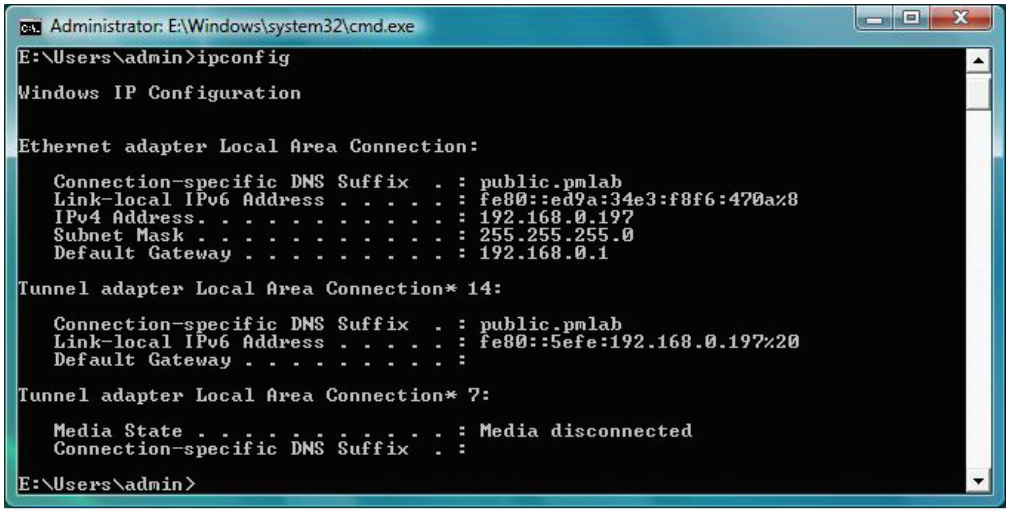
If the address is 0.0.0.0, check your adapter installation, security settings, and the settings on your router. Some firewall software programs may block a DHCP request on newly installed adapters.
Statically Assign an IP address
If you are not using a DHCP capable gateway/router, or you need to assign a static IP address, please follow the steps below:
Click on Start > Control Panel (make sure you are in Classic View). Double-click on the Network and Sharing Center icon and then click on Change adapter settings.
Right-click on the Local Area Connection which represents your D-Link wireless network adapter which will be connected to your network.
Highlight Internet Protocol Version 4 (TCP /IPv4) and click Properties.
Click Use the following IP address and enter an IP address that is on the same subnet as your network or LAN IP address on your router or network. Example: If the router’s LAN IP address is 192.168.0.1, make your IP address 192.168.0.X where X is a number between 2 and 99. Make sure that the number you choose is not in use on the network.
Set Default Gateway the same as the LAN IP address of your router or gateway.
Set Primary DNS the same as the LAN IP address of your router or gateway.
The Secondary DNS is optional (you may enter a DNS server from your ISP).
Click OK to save your settings.
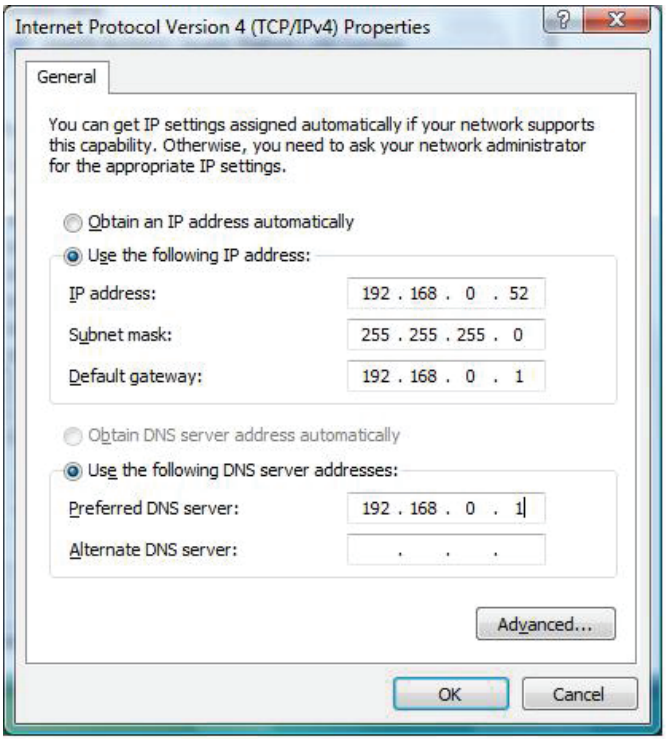
Registration
Pros & Cons
Pros
- Compact nano design for minimal obstruction
- Supports MU-MIMO technology for simultaneous data transmission
- High-speed WiFi connectivity up to 600 Mbps
- Backward compatible with older WiFi standards
- Affordable pricing
Cons
- Limited range compared to larger adapters
- No external antenna for signal enhancement
- May require frequent driver updates
Customer Reviews
Customers have generally praised the D-Link DWA-181 for its performance and convenience. Many users have noted that it significantly improves their WiFi speeds and reliability. However, some users have reported occasional connectivity issues and the need for frequent driver updates.
Most Common Complaints
Some of the most common complaints include:
- Frequent disconnections requiring restarts
- Occasional slow speeds despite being close to the router
- Difficulty in installing drivers on certain operating systems
Faqs
What is MU-MIMO technology and how does it benefit the D-Link?
Is the D-Link compatible with my older router?
How do I update the firmware of my Wi-Fi Nano USB Adapter?
Can I use the AC1300 MU-MIMO Wi-Fi with macOS?
Why does my DWA-181 keep disconnecting?
How do I improve the WiFi signal strength with the Nano USB Adapter DWA-181?
Is the D-Link MU-MIMO Wi-Fi secure?
Can I use multiple DWA-181 adapters on the same device?
How do I reset my D-Link AC1300 MU-MIMO to its factory settings?
Leave a Comment
